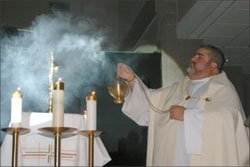Questions & Answers: Incense
by Ann Ball
This article appeared in the September-October 1996 edition of Catholic Heritage magazine, formerly published by Our Sunday Visitor, Inc.
The magazine is no longer being published.

In ancient times, people believed that whatever delighted the human senses must also be pleasing to the gods.
They felt that through the burning of sacrificial offerings — and the ascension of the smoke — their gifts were transported into the realm of divinity.
In those days, modern sanitation was unknown and bathing was a luxury.
No wonder incense, perfumes and other sweet-smelling items were popular.
In recent times, science has discovered smell is the only sense wired directly to the limbic system, sometimes called the "old mammalian brain."
That's what regulates vital autonomic functions, biological rhythms and basic instincts.
In other words, our sense of smell affects the source of our most powerful emotions.
- Who were the first people known to use incense?
- a. the Egyptians
- b. the Romans
(a.) The earliest recorded use of incense is found in Egyptian hieroglyphics.
About 1500 BC, Queen Hatshepsut sent a fleet to what is now part of northern Somalia to acquire frankincense and myrrh tree seedlings, the two "perfumes of the gods."
When the tomb of Tutankhamen ("King Tut," c.1340 BC) was opened in the early 20th century, the air inside still smelled of myrrh.
- In addition to the Ten Commandments and other instructions, Moses brought two recipes down from Mount Sinai.
What had he been told to make?
- a. sacred bread and cheese
- b. sacred incense and anointing oils
- c. sacred incense and lamp oil
(b.) The recipes were for sacred incense made with frankincense and sacred anointing oils with a myrrh base [See Exodus 30:22-38].
"Bread and cheese"...
No, Yahweh wasn't recommending the Israelites enjoy a fondue brunch!
- The Magi brought gifts of gold, frankincense and myrrh to the Messiah.
All were rare and costly commodities in the ancient world.
From what part of the tree are frankincense and myrrh made?
- a. the leaves
- b. the bark
- c. the sap
(c.) Both frankincense and myrrh are aromatic gum resins: dried tree sap.
Because the trees were scarce and difficult to transplant, and harvesting was a laborious process, the resins were very valuable.
Around the time of Christ, a pound of frankincense cost more than the equivalent of $500 in today's currency; a pound of the choicest myrrh was as much as eight to ten times that amount.
- Why was the use of incense not a part of the earliest Christian worship?
- a. because of its pagan connections
- b. because early Christian worship was held in secret

(a.)... and (b.) Scholars believe both answers are correct.
During the Roman persecutions, Christians were ordered to offer incense before an image of the emperor or other pagan deity.
Those who capitulated were called "thurificati," after the "thurible," or censer, in which incense was burned.
Since much of early Christian worship was held in secret, the strong odor of incense might have meant discovery and persecution.
- Incense is still used in the Church today.
In the Catholic tradition, the rising smoke symbolizes what?
- a. the Resurrection and the Ascension
- b. the presence of the Holy Spirit among the community
- c. the prayers of the people as well as their sanctification
(c.) The rising smoke suggests the ascent of the prayers of the faithful gathered there.
The ritual censing of church objects symbolizes sanctification (to "sanctify" is to "make holy").
And the censing of the worshipers not only implies sanctification, but also celebrates participation in the liturgical ceremony.
Ann Ball is the author of Catholic Book of the Dead and Catholic Traditions in Cooking, published by Our Sunday Visitor
|



